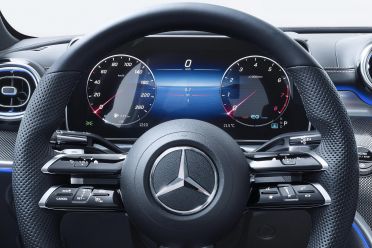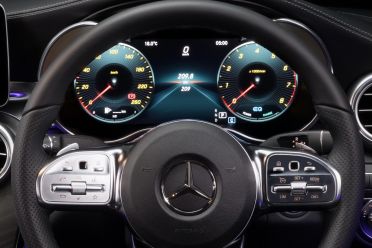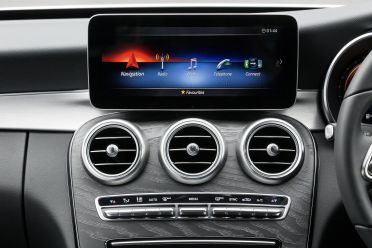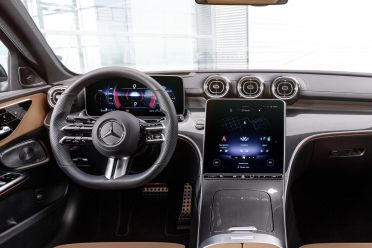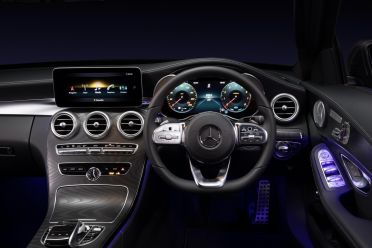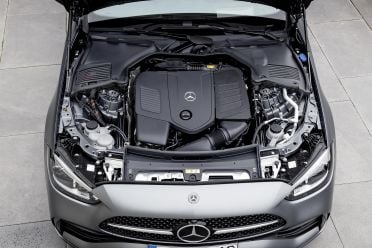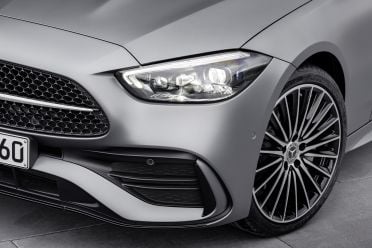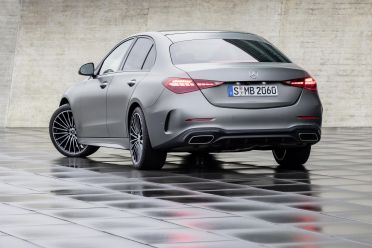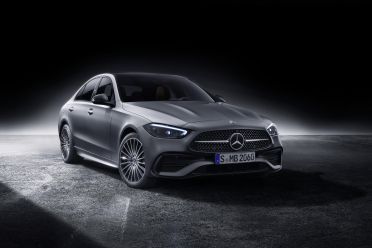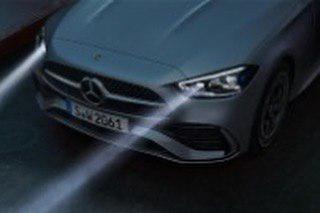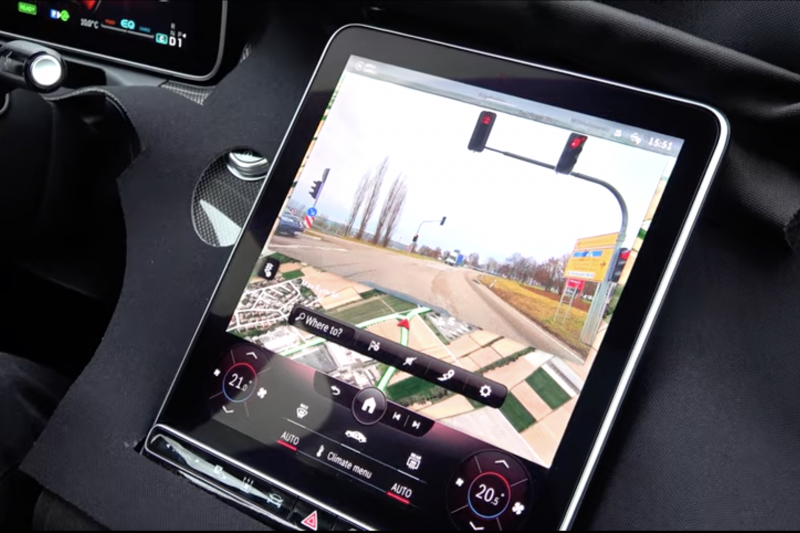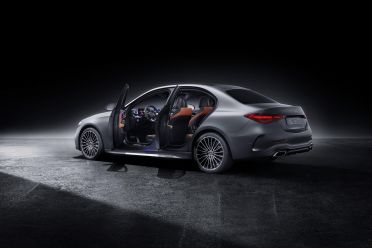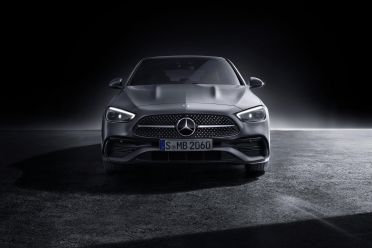The Mercedes-Benz C-Class has been Australia’s top-selling luxury sedan for years now, but the ageing outgoing W205 model was pipped at the post by its newer BMW 3 Series arch rival in 2020.
The good news for both Mercedes-Benz and its fans is the imminent arrival of the W206 generation. It’ll touch down in Australia by end of 2021.
Should you be preparing to upgrade?
The slider images you see, with the dividing white line, allow you to view the new and old models. Just drag the line across the image.
Exterior
The design is an evolution of the outgoing car, rather than a revolutionary change.
There are all manner of grille designs which makes direct comparisons tough, but the star design on the AMG Line version pictured is rather sleek. The bonnet has ‘power domes’ on it, meaning ridges, and the badge has been moved ahead of the bonnet shut-line.
LED headlights are standard, and you can option the S-Class’s Digital Light System that can project guidelines or warnings onto the road. The light is refracted by a claimed 1.3 million micro-mirrors per headlight, meaning a resolution above 2.6 million pixels per vehicle.
The lower side character line is similar, but the upper shoulder line in the new model doesn’t taper downwards as it did on the old vehicle. As the side-by-side shot above shows, the silhouette is familiar but the overall look is cleaner.
The tail lights are slimmer and more triangular than before, with different LED designs. There’s also no longer a trim piece mounted beneath the rear badge. Finally, the exhaust outlets on the vehicle pictured are more rectangular.
As the table below shows, the new model is longer and lower than before. It retains an unchanged 0.24 coefficient-of-drag.
| New | Old | Change | |
|---|---|---|---|
| Length | 4751mm | 4686mm | +65mm |
| Width | 1820mm | 1810mm | +10mm |
| Height | 1438mm | 1447mm | -9mm |
| Wheelbase | 2865mm | 2840mm | +25mm |
Interior
Things are far more revolutionary inside. The new steering wheel has a bolder centre badge and new twin-side-spoke design. The vents are mounted slightly higher – ditto the starter button – and are squared-off.
The old driver instruments under a binnacle cover are gone, replaced by a high-resolution LCD free-standing screen. Base models of the new car will use a 10.25-inch or 26cm display and top grades will use a 12.3-inch or 31cm display.
The centre fascia is now tilted towards the driver and fully digitised. The old tablet screen above buttons and a control pad on the transmission tunnel have been replaced by a large portrait-oriented touchscreen with a black haptic toolbar and fingerprint sensor (for quick access to your Mercedes Me account) beneath.
On entry grades the centre tablet is 9.5 inches or 24cm diagonally, whereas the upper grades get an 11.9-inch or 30cm diagonal display.
Beneath this is a large closing cubby right where the old infotainment controller device lived.
The new C-Class gets the second-generation MBUX in-car operating system.
The processing and graphics are slicker, the augmented reality navigation system has been expanded, the Alexa-style ‘Hey Mercedes’ voice control system is always growing its vocabulary, and you can update the system over-the-air.
In terms of room, boot space is the same but the interior is otherwise larger in every area. See the table below.
| New | Old | Change | |
|---|---|---|---|
| Front headroom | 1041mm | 1039mm | +2mm |
| Rear headroom | 955mm | 942mm | +13mm |
| Rear legroom | 914mm | 893mm | +21mm |
| Front elbow room | 1476mm | 1454mm | +22mm |
| Rear elbow room | 1477mm | 1462mm | +15mm |
| Front shoulder room | 1430mm | 1404mm | +26mm |
| Rear shoulder room | 1411mm | 1398mm | +13mm |
| Boot space | 455L | 455L | 0 |
Drivetrains
The Mercedes-AMG C43 and C63 will be detailed at another time.
The launch range for C-Class comprises various four-cylinder engines, all with turbocharging and a 48V electrical system and integrated starter-generator.
This system can add low-end boost (up to 15kW), run core functions with the engine decoupled off-throttle (gliding), and run an energy recuperation system.
The new nine-speed automatic transmission houses the drivetrains’ electric motors, power electronics and coolers. Both rear-wheel drive and 4Matic all-wheel drive are available.
There are petrols and diesels for Europe, but Australia will see only petrol models.
The figures including comparable WLTP consumption data below.
| C200 petrol | New | Old |
|---|---|---|
| Displacement | 1.5-litre | 2.0-litre |
| Power | 150kW | 150kW |
| Torque | 300Nm | 300Nm |
| Boost | 15kW/200Nm | |
| Fuel consumption | 6.2L/100km | 6.4L/100km |
| CO2 | 141g/km | 146g/km |
| 0-100km/h | 7.3 seconds | 7.1 seconds |
| C300 petrol | New | Old |
| Displacement | 2.0-litre | 2.0-litre |
| Power | 190kW | 190kW |
| Torque | 400Nm | 370kW |
| Boost | 15kW/200Nm | |
| Fuel consumption | 6.6L/100km | 6.9L/100km |
| CO2 | 150g/km | 157g/km |
| 0-100km/h | 6.0 seconds | 6.0 seconds |
The other drivetrain detailed is a plug-in hybrid (PHEV), with Mercedes-Benz targeting a maximum pure-electric driving range of 100km before you need a drop of petrol.
The outgoing C300e did around 50km by way of comparison.
Underneath
Mercedes-Benz claims there’s a new multi-link (four linkages per wheel) front axle and revised subframe-mounted rear multi-link setup.
Adjustable dampers should be standard in Australia, and air suspension an option (standard on PHEV).
Another new feature on the W206 C-Class is rear-axle steering which turns the wheels up to 2.5 degrees in the opposite direction to the front wheels below 60km/h, and the same direction above 60km/h.
The steering ratio has been changed to make directional changes more direct, and the urban turning circle is tighter.
Safety
Mercedes-Benz has tweaked the active safety systems.
Active cruise control can notice stationary vehicles when you’re travelling at 100km/h (previously 60km/h), there are claimed improvements to the active lane-keeping aid with a higher 210km/h threshold, more accurate cameras, and the traffic sign recognition system now recognises signs on overhead gantries and at roadworks.
The self-parking system is also better, and is recalibrated if you option the rear-axle steering.
Other additions include a front-centre airbag to mitigate head clashes in side impacts, new side crumple zones for impact protection, and a system that can move the affected passenger away from an impending side impact before cushioning them with inflating air chambers in the side bolsters.
MORE: Mercedes-Benz C-Class news, reviews, comparisons and videos
MORE: 2022 Nissan Qashqai – What’s new compared to the old one?




